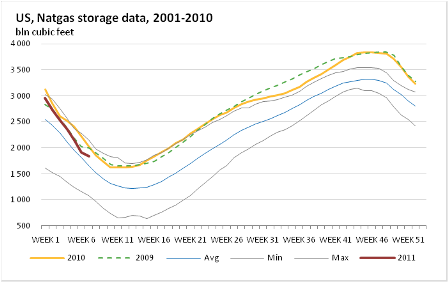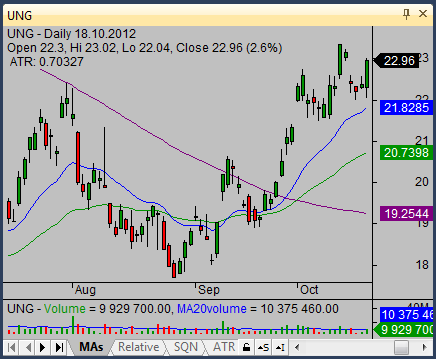The natural gas ETF is one way how to participate in huge price swings in commodities. There is a special commodity ETF with the symbol UNG.
I recommend to my clients, and also when I discuss with longer-term investors, to be more active and self directed investors rather than pure buy-and-hold investors, especially when we speak about using commodity ETFs.
The natural gas ETF with symbol UNG is constructed in a way that sells a first futures contract and buys into a second contract each month in order to keep its exposure to natural gas. Contango is a negative difference in price between first and second futures contract.
By definition, rolling Contango means losing money for UNG each month. As such, Contango is a result of overcapacity where producers are selling into a well supplied market. As stocks of natural gas are very high, the cost of storage is not negligible.
Picture with Natural Gas storage data analysis:

Sellers have little pricing power in the front contracts as the market is aware of a glut. Contango reflects a perception of low risk being needed gas in the spot market in the future. Today (2011) I see little threat of supply shocks, as producers can ramp up drilling very quickly. On-shore natural gas drilling is quite flexible. Contango should therefore prevail.
The sole risk could be posed by changes in environmental regulations or any environmental events causing a sudden stop in drilling. Therefore my opinion is that this commodity ETF with symbol UNG is a very good short, even if it is not so perfect as a hedge.
Short term trading with UNG
UNG offers also short-term trading opportunities for ETF traders. If you have this commodity ETF in your regular watchlist, you can spot such a good opportunity from time to time.

It was a huge downtrend in last few years, but the price recently started to show signs of stabilization. This situation offers many short-term trading opportunities on both sides of the market – the bullish and the bearish as well.
Find more on related pages
- Study also this energy commodities trading strategy example
- Identify further ways to spot alternative energy etf opportunities
- Find more best ways to invest money